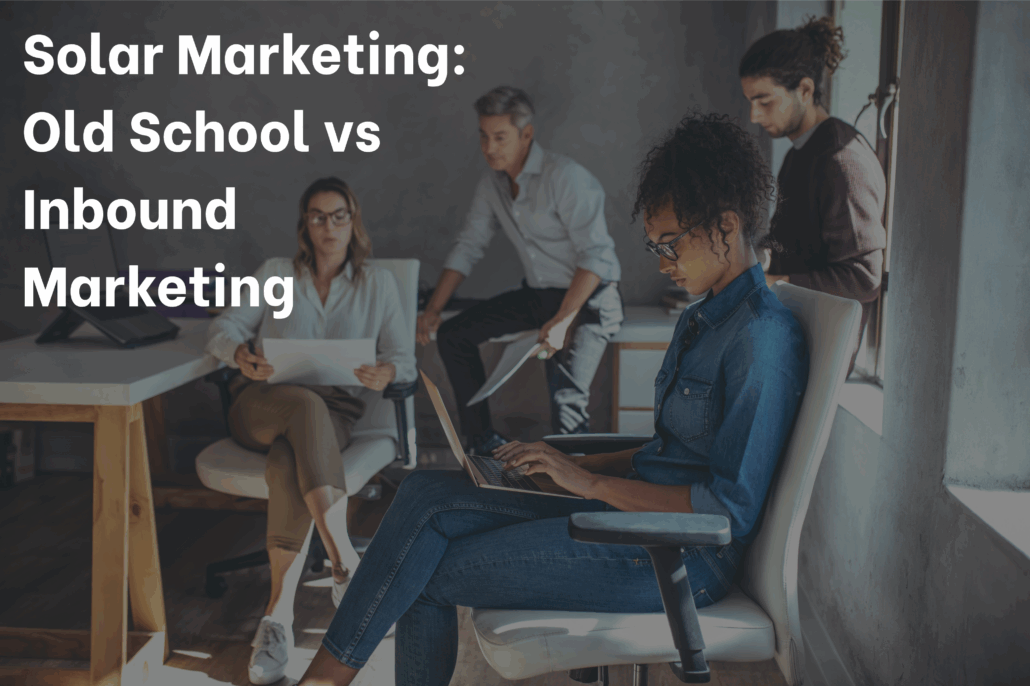
As Americans continue to rapidly go solar, the competition amongst installers has rapidly increased. The solar marketing techniques and strategy that only a few years ago led brands to rapid customer acquisition aren’t enough anymore. They’re inefficient and expensive, and they are hard to scale. As a marketing agency that is on the front lines facilitating large scale customer acquisitions for solar companies around the nation, we’ve adapted with the changing marketing ecosystem to continue delivering for our clients. Here are a few of the lessons we’ve learned over the past couple years when evaluating solar marketing efforts.

Finding and converting customers is the most important part of any solar company’s business. However, with the ever-changing landscape of marketing channels, it can be difficult to evaluate which channels and tactics are worth pursuing. Traditional Solar marketing channels typically rely heavily on paid lead providers like SolarReviews.com, HomeAdvisor, Angies List, and others. These lead providers have previously been seen as essential for solar companies to access potential customers at a reasonable cost.

Paid lead providers offer solar companies an easy way to access new leads that are already interested in buying a solar system. That said, there are several disadvantages of paid lead providers. Here are a few to consider:
Unreliable Lead Quality
The quality of leads from paid providers is unreliable due to the nature of their acquisition process. A good example is SolarReviews.com, which has recently increased its prices significantly—making it impossible for solar companies to sustain the same level of leads at the same cost. As such, you may end up spending more money on fewer leads or settling for lower quality leads than you would receive from other sources.
Leads Haven’t Interacted with Your Brand Before Paying
Another disadvantage of using paid lead providers is that potential customers have not interacted with your brand before paying for leads. This means that they haven’t had the chance to get to know your company and build trust in what you have to offer—making it more difficult to convert them into actual customers.
Increasing Cost
Paid lead providers can also be expensive over time as they inevitably increase their prices over time, leaving you with fewer leads at higher costs than when you started out. Additionally, many providers require contracts that lock you into specific terms and conditions—which can limit your ability to switch if prices change or customer satisfaction drops off substantially over time.
The second reason that costs increase with time is that because you are not building your brand when buying paid leads, you build almost no long term value from the marketing spend. This leaves companies highly susceptible to changing market conditions and reduces long term viability.
The Need To Build A Large And Sophisticated Call Center To Manage These Leads Effectively
Finally, using paid lead providers requires building a large and sophisticated call center in order to manage these leads effectively. This means investing in additional staff and resources in order to ensure that incoming calls are answered promptly and efficiently by knowledgeable representatives who are able to properly assess customer needs and provide relevant solutions accordingly. The cost associated with this type of setup can quickly add up; so it’s important to factor this into any decision about whether or not paid lead providers make sense for your solar installation business. We’ve seen this cost for clients quickly exceed $1 million dollars in annual overhead.
Despite the drawbacks of relying too heavily on paid lead providers, there are still other options that can help you reach new customers without sacrificing control over your lead quality or budget. We recommend using inbound marketing tactics to develop a complete marketing machine which will draw in qualified leads at costs that fit your budget.

In order to reduce reliance on these paid lead providers, solar companies need to build their own inbound marketing channels. Inbound marketing is a business methodology that attracts customers by creating valuable content and experiences tailored to them. This form of marketing stands apart from traditional outbound methods which often rely on interrupting potential audiences who may not be interested or eager for such communication.
By diversifying their solar marketing efforts and focusing on building sustainable inbound marketing channels, solar companies gain a number of benefits such as: generating quality leads, gaining more control of their lead pipeline, and having more choice in how their dollars are spent per lead.
Below, we’ll discuss the different types of inbound marketing channels that solar marketers should consider, including search engine optimization (SEO), pay-per-click (PPC) advertising, YouTube videos, paid social media advertising, and programmatic display advertising.

There are many channels for marketing a solar company, but search engine optimization (SEO) is one of the most important. SEO is a process that helps your website rank higher in search results, increasing visibility and driving organic traffic to your site. This can be a great way to build awareness of your company and attract high-quality leads without having to pay for ad space or click costs. Let’s take a look at how SEO works and why it’s so important in the solar industry.
How SEO Works
SEO relies on optimizing content around relevant keywords and phrases. Behind all online searches is powerful technology – algorithms that scour through web pages to uncover exactly what people need. In three distinct steps, from discovering content on the web (crawling), filing relevant information for future use (indexing) to providing website rankings based on user queries (ranking); search engine algorithms read and rank your site based on the quality of your SEO optimization.
There is an intricate web of over 200 ranking signals helping to shape your website’s visibility in the digital space. These crucial factors are categorized into three distinct pillars: technical optimization, on-page optimization and off-page optimization. Some notable examples include keyword presence within title tags – ensuring these keywords or synonyms appear on each page; loading speed being a pivotal factor for mobile users; as well as reputation playing a hand in search results by indicating whether it is considered reputable according to the criteria provided.
Search engine optimization (SEO) involves optimizing websites so they appear higher in organic search engine results pages (SERPs). By understanding what people are searching for when they look up solar companies, you can create content that will appear higher in search results.
For example, if someone searches “Solar panel installation near me”, you may want to include those exact words or similar phrases on your website so that it appears higher in the results. This type of optimization helps your website rank higher on SERPs and increases visits from potential customers who are actively looking for solar services.
More and more people are using their phones as their primary device for searching and browsing online content, so having a mobile-friendly website is essential for any solar company. Mobile optimization is especially important because it affects page loading speed which can be a major factor in deciding how quickly users convert into customers. Slow page loading speed also impacts user experience which can hurt your rankings on SERPs if ignored.
It’s important to optimize all aspects of your website including images and videos so that they load quickly on different devices and browsers. Additionally, make sure there are no broken links or other errors on the site as this can further affect loading speed and rankings.
Having positive reviews from past customers shows potential new customers that you have earned a positive reputation through providing good quality services. Reputation management has become an increasingly important factor when it comes to SEO rankings since Google began using its algorithm to measure reputation. Therefore, it is essential to focus on reputation management by responding promptly to customer feedback as well as monitoring online reviews regularly to ensure they remain positive and accurate.
Additionally, having social media accounts help boost your reputation with Google’s algorithm by showing them how active you are online and providing another avenue for customers to reach out directly with questions or comments about your services or products.
The Benefits of SEO for Solar Companies
There are many benefits of using SEO as part of your solar marketing strategy. First, it can help drive high-quality leads to your website by targeting users who are actively looking for what you offer. Plus, because this is an organic source of traffic, it won’t cost you anything extra beyond the time spent researching and creating optimized content. Finally, SEO also helps build credibility and trust. As an article on Forbes points out, “A site that ranks high on search engine results pages is typically considered high-quality and trustworthy by search engines, and this, in turn, boosts the credibility of your business.”

Video content is incredibly effective when it comes to connecting with an audience, and YouTube is the perfect platform for creating engaging video content to market solar products and services. With YouTube’s wide range of targeting options, solar companies can reach their ideal customers with precision. Let’s explore how solar installers can use YouTube videos to increase visibility and engagement.
Creating Quality Content
The first step in leveraging YouTube as a marketing tool is to create high-quality content that engages viewers while also providing meaningful information about the company’s solar product or service offering. Videos should be informative, easy to understand, and entertaining. Additionally, it’s important for companies to communicate their brand’s message in a clear and consistent manner across all videos produced for their channel. This will help ensure that viewers have a positive experience when viewing the company’s videos, making them more likely to continue watching future videos.
Using Targeting Options
YouTube provides various targeting options such as age, gender, location, interests, and device type that allow companies to better target their ideal customers with precision. By leveraging these targeting options in combination with high-quality video content, companies can easily increase engagement with potential customers who may not otherwise be aware of the company’s offerings.
Additionally, by utilizing YouTube Ads Manager companies can create ads tailored specifically for each target audience segment they wish to reach. This allows companies to maximize their ad spend by ensuring that ads are being seen by those most likely interested in what the company has to offer.
Integrating Other Platforms
Leveraging other platforms such as Facebook and Instagram is another great way for solar companies to further expand the reach of their video content on YouTube.
By sharing links from YouTube videos on other platforms they are able to increase viewership while also giving potential customers an easy way of finding out more about the company’s offerings without having to leave the platform they’re already using. Additionally, this allows for greater reach into different demographics who may not have found out about the company otherwise.
You can learn more about the benefits of YouTube advertising here.

Paid social media advertising offers another way to get your solar solutions or products in front of the right audience. From Facebook and Instagram to Twitter and LinkedIn, social platforms offer comprehensive targeting options so that businesses can narrow down their desired audience based on location, interests, age range, and more. Let’s take a closer look at why paid social media campaigns are worth considering for your solar company.
Benefits of Paid Social Media Advertising
One of the main benefits of paid social media advertising is that you can set a specific budget and duration for your campaigns. This allows you to test different campaigns without worrying about spending too much money. Additionally, paid social media ads provide detailed analytics reports so that you can track your performance and make adjustments as necessary. This data gives you the ability to optimize your ad campaign for maximum results.
Another great benefit of paid social media advertising is that it allows you to target very specific audiences with laser-focused precision. For example, if your solar company offers residential solar solutions, then you can create an ad campaign specifically geared towards homeowners in a certain area who are interested in renewable energy sources. You can also use creative visuals such as videos or infographics to capture people’s attention quickly and effectively.
Targeting Options
The various targeting options offered by the different platforms allow businesses to narrow down their desired audience based on demographics like age range or gender, interests or hobbies, income level or job title, etc. With these targeting options in place, it becomes easier to find potential customers who are more likely to be interested in what you have to offer and convert them into paying customers. Additionally, many platforms also allow businesses to target people based on previous interactions with their website or other online activities such as search queries on Google or Yahoo! Lastly, some platforms also let businesses retarget previous website visitors so they can continue engaging with them throughout their journey from awareness stage all the way up until conversion stage.

Programmatic display advertising is another useful tool in the solar marketer’s arsenal as it allows solar businesses to advertise across a wide range of websites quickly and easily.
What is Programmatic Advertising?
Programmatic advertising is an automated process by which online advertisements are bought and sold on the open market. Instead of manual negotiation between buyers and sellers, programmatic technology uses software to automate the process. This means that advertisers can purchase ad space with far greater efficiency than ever before – providing them with access to billions of monthly impressions generated by partner websites while still maintaining control over where their ads appear online.
Benefits of Programmatic Display Advertising
The most obvious benefit of programmatic display advertising is its speed and efficiency. By using programmatic technology, advertisers can create campaigns within minutes rather than hours or days as was previously required for manual negotiations.
Additionally, programmatic tools allow for more precise targeting as well as sophisticated optimization techniques that enable advertisers to focus on specific audiences or demographics in order to maximize conversions and ROI.
Finally, programmatic display advertising gives advertisers access to numerous networks such as Google Display Network (GDN), Microsoft Advertising (formerly known as Bing Ads), and AdRoll – giving them far greater reach than they could achieve through manual negotiation alone.

Solar companies need to focus on building their own inbound marketing channels in order to reduce reliance on paid lead providers. This can be done through a variety of methods such as SEO, PPC advertising, YouTube videos, paid social media advertising, and programmatic display advertising. By doing so, solar businesses can save money while claiming ownership of their marketing and continuing to generate quality leads.
With RELLO’s solar marketing strategies, you can seize this opportunity to get ahead of industry trends. Our team has worked with many leading companies in the solar sector, so let us help bring results for YOUR business! Fill out the form below if you’re interested in talking more about how we could work together. Don’t miss your chance – it starts here!
Fill out our form and a member of our team will be in contact soon. Let’s discuss your marketing needs and see what RELLO can do for you.
Was this post helpful? Share it online.